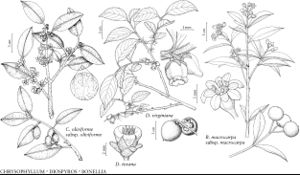Bonellia
Hortus Ripul., 21. 1824 ,.
Shrubs or trees, resin canals absent. Stems erect, much-branched; young branches puberulous, hairs relatively short, uniseriate [glabrous]. Leaves alternate or pseudoverticillate; blade elliptic to oblanceolate, base obtuse [attenuate], margins entire [serrate], apex obtuse to acute, aristate [mucronate or mucro absent], surfaces glabrous [pubescent], punctate. Inflorescences terminal racemes, 5–20-flowered, pedunculate. Pedicels present, bracteate. Flowers: sepals distinct; corolla yellow or orange [white or whitish], salverform or short-campanulate, lobes as long as or longer than tube, apex obtuse; stamens borne at base of corolla tube; filaments distinct; anthers at first aggregated around stigma and style, later spreading; staminodes borne at apex of corolla tube, petaloid; stigma capitate, lobed. Berries yellow [orange], ovoid or globose, apex apiculate. Seeds 1–8, dark brown, oblong or elliptic, flattened, slightly alveolate, partially covered by placental tissue.
Distribution
Introduced; Fla., Mexico, West Indies (Greater Antilles), Central America, South America.
Discussion
Species 22 (1 in the flora).
